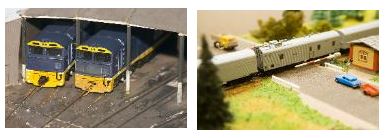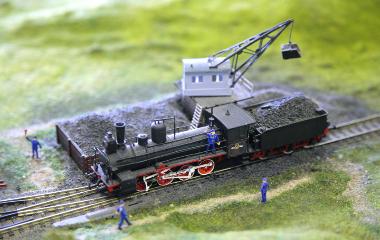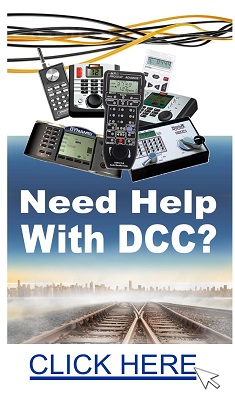|
Question: "I only plan on having 2 locomotives on my set and
wonder if I should still put in a separate programing track for DCC?"
Answers: Jack comments - "No, you do not have to. In dcc track is
always hot (19v) the engine gets commands via radio directly from your controller.
IUnless you have a large layout and weak controller. DCC is design to eliminate
this problem."
Another comment - "Depending on what DCC system that you purchase you can program
on the main line. Make sure that you don't have multiple engines on the track or be
careful that you use the correct engine numbers or what ever you use. MRC allows
you to program on both the main line and test track."

Question: "I would like to know what is the difference in
code100 and code 83 track and how locomotives get there numbers?"
Answer: A reader comments -Code 100 rail is .100 inches high
from base to running surface. Code 83 is .083 inches high. Therefore, the
difference is .017 inches. The loco number question is more complex as there are
(at least) two different schemes:
1. In the US, the Whyte System counts the wheels of each axle group on the loco,
e.g. a wheel arrangement of oOOOO = 2-8-0, or 'Consolidation' type; likewise,
ooOOOo = 4-6-2, or 'Pacific' type. Other countries may use a different scheme.
2. The 'Official' number painted on each loco may depend on the parent railroad,
the assigned "class" of locomotive and/or the order of purchase. For example, the
Denver & Rio Grande RR classified its (Narrow Gauge) Consolidations (2-8-0) as
'C' beginning with C-16. The Mikado (2-8-2) as 'K', beginning with K-27 and
numbered from 450.
Question: Alan asks - "I am having a lot of trouble with smooth
joints on curves where I have to make a joint in flex track. Even if I start with a
fresh piece at the beginning of the curve I can't make it all the way around. Then
there is a goofy spot where ties have been removed and the track is joined. I have
soldered the joints with a heat sink to prevent melting the remaining ties, but
they still are not great. Does anyone know what I should do?"
Answers: Anonymous relied - "I think your problem is you are
trying to attach flex track while still in curve. As you attach the first piece old
flex, pin it down, cut the first two ties from the rail but not off completely. Cut
just the part that holds to the track. Take a piece of sandpaper and sand the ties
a little so the joiners can slip on the rails. Place other flex track and trim for
the joiners and rail length. Attach flex track and pin it down. Then solder the
rail joint if you want."
Dr Pete relied - "The radius of your curve has a lot to do with a smooth even
joint. I have found that a radius of more then 26" works well and the larger the
better. Snap track for smaller curves such as 18" or 22" is the best answer.
Another suggestion is to offset your joint. Make one rail an inch or so longer then
the other. Carefully separate your ties from the rails. Do not break it off. If you
use a cork roadbed simply use railroad spikes (HO for example) and carefully
realign and spike the rails in place. As you said a soldered joint rather then a
fish plate also works well. BUT it takes patience and care. You will be pleased by
smooth operation so the time spent is well worth it."
Chuck relied - "I HAD THE SAME PROBLEM YEARS AGO AND I CUT OFF THE INSIDE RAIL
ABOUT A 1" OR MORE TO MAKE THE OUT SIDE TRACK LINE UP WITH THE OTHER RAIL."
Gator replied - "I have used a couple of long pieces of flextrack on my current
layout for some non-standard curve radii (one greater than 22" and the other
between 18" and 22"). Where the flex track has to have the ties trimed out to fit
the rail joiners, I carefully cut the ties out and then when the track was in place
and joined, I would use the cut pieces to replace the ties in an appropriate
looking manner using the same adhesive to put them in place as I used to put the
track in place with (bathroom tile caulk is what I use). It takes a little bit of
extra time but it can fill in an empty spot and after the ballast id put down you
can not tell the ties were ever missing."
The Engineer replied - "Hey Alan: What I find to be most helpful to eliminate
the kinking and track gauge issue of making a joint in the middle of a corner is to
solder the track in its natural straight (unstressed) position that way when you
lay the track it will flow like a one long piece of ribbon rail."

Question: Zac asked - "I'm in the essential planning phase of
my HO layout. I have got 10'x7.5' to work with. I am wanting to do a large mountain
with 2 tunnels and a bridge on one side. I could go on and on with plans. I would
be interested in getting feedback and ideas from your readers to help me plan my
layout. Thanks Zac"
Answers: Bill replied - "I have seen mountains like you want on
sites on the Internet. Most seem to build and then fill in after with styrofoam and
crackfill this worked for me ] also with a big project like yours consider having
the mountain in sections to allow easy access. Good Luck."
Rick replied - "A large mountain in the space you have will be a challenge;
however, it can be done. I'll be doing something similar in that it will be "half a
mountain". It will be about a 60% angle from the base of the mountain to the
backdrop. I used a printed mountain picture on the backdrop to "continue" the
mountain into the distance. Hope this helps. Rick."
|
Question: "I have a question for a model railroader who reads
your blog to answer please. I am starting to build a board for the layout. I have 2
Lionel train sets with a few pieces of extra track I purchased. What is the angle I
may use for elevation of the trains? What rate of elevation can they climb? Does
one of your readers know the answer?"
Answers: Gator comments - "It is my understanding that 2%
incline is pretty well standard incline for all scales...I know it works well with
HO and anything steeper doesn't."
Ron replied - "Hi fellow modeller, my name is Ron and I have been a modeller for
quite a number of years. I have often created layouts with steep gradients (as much
as 70 degrees) I find that a good wire brushing ACROSS the tracks gives the track a
'caterpillar tread' which gives the train a good grip. I hope this helps."
Anonymous replied - "I agree with 'gator- - about 2% is average, so as to give
good working & less strain for the loco. That said, I have an inclined section
on my layout (a bi-pass loop) that slopes up to 4%. I tend to use it only in the
downward direction, but all my loco's can quite easily negotiate that grade,
albeit: with limited sized train. Any steeper grading limits the size of a train
and if too steep, the track looks unreal & toy-like."


Question: Cal asked - "I would like to put up a curved backdrop
to be paintable as sky & clouds. Where can I find a roll of cardstock about 36"
high that will work? I need about 50' roll. Is there something better to use?"
Answer: Anonymous replied - "You could use 2-3mm ply or MDF. It
will have less tendency to droop if it gets damp but will follow a curve in the
same way."
Question: Doug asked - "What do I have to do, or is it even
possible, to run a RailKing Proto Sound II DCS engine on Lionel setup using TMCC.
If not, can the reverse work - in other words, if I purchase the Railking DCS will
Lionel TMCC trains run on that system? Can one of your readers please help me."
Answer: Bill T replied - "Yes, The opposite is true. You
need to get the MTH (Rail King) DCS system and it will run all of your Lionel TMCC
items just fine. But Lionel, even the new Legacy system, will not run MTH PS-2
products."
Question: Colin asked - "What is the best and easiest way of
making a good joint on N gauge flexi track and set track. I have noticed if you
undo a joint the fishplates spread to much to rejoin and make a good contact."
Answer: Malcolm replied - "The fish plates are being opened up
by the burr left after cutting the flexitrack. Be sure to file this off paying
particular attention to the rail sides as it is this area that normally opens up
the fish plate. If your fish plates have opened out at the top then the side burr
is the cause. A burr on the rail base normally makes it difficult/impossible to get
the fish plate on in the first place."
Question: Steve asked - "I am currently planning a layout of
33ft x 14ft. As there will be a fair number of trains running at the same time, I
want to keep the noise level of the track down as much as possible. Can you suggest
what material I should build the base board out of. I was thinking of foam but will
that keep the noise and vibration down compared to plywood or is there a better
way. Thanks"
Answer: Mark replied - "Most articles I read the builders use
1/4 inch or 1/2 inch plywood covered with the thicker blue or pink foam insulation.
They claim the white beaded foam is to messy. Finally they glue cork down on top of
the foam. Myself I do the same as above using 1/2 inch plywood for more stability.
I don't know if the 1/2 inch is actually needed or not but I feel better using it
and my railroad is not meant to be transported to shows etc. So weight is not an
issue. The cork on top of the foam should also help tone down the noise quite a lot
and give you that realistic profile of a mainline. Also if your engines are sound
equipped you may want to keep the sound at a minimum since you intend to run
several trains at once otherwise it may become somewhat annoying *so they say* Hope
this helps a little!...Mark"
View model train club
videos
|

